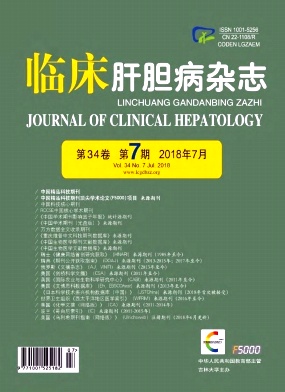|
[1]SANGIOVANNI A, DEL NINNO E, FASANI P, et al.Increased survival of cirrhotic patients with a hepatocellular carcinoma detected during surveillance[J].Gastroenterology, 2004, 126 (4) :1005-1014.
|
|
[2]IKEDA K, OSAKI Y, NAKANISHI H, et al.Recent progress in radiofrequency ablation therapy for hepatocellular carcinoma[J].Oncology, 2014, 87 (Suppl 1) :73-77.
|
|
[3]FONSECA AZ, SANTIN S, GOMES LG, et al.Complications of radiofrequency ablation of hepatic tumors:Frequency and risk factors[J].World J Hepatol, 2014, 6 (3) :107-113.
|
|
[4]KIM GM, WON JY, KIM MD, et al.Cryoablation of hepatocellular carcinoma with high-risk for percutaneous ablation:Safety and efficacy[J].Cardiovasc Intervent Radiol, 2016, 39 (10) :1447-1454.
|
|
[5]LU DS, YU NC, RAMAN SS, et al.Percutaneous radiofrequency ablation of hepatocellular carcinoma as a bridge to liver transplantation[J].Hepatology, 2005, 41 (5) :1130-1137.
|
|
[6]LU DS, RAMAN SS, LIMANOND P, et al.Influence of large peritumoral vessels on outcome of radiofrequency ablation of liver tumors[J].J Vasc Interv Radiol, 2003, 14 (10) :1267-1274.
|
|
[7]MULIER S, NI Y, JAMART J, et al.Local Local recurrence after hepatic radiofrequency coagulation:Multivariate meta-analysis and review of contributing factors[J].Ann Surg, 2005, 242 (2) :158-171.
|
|
[8]LENCIONI R, CIONI D, CROCETTI L, et al.Early-stage hepatocellular carcinoma in patients with cirrhosis:Long-term results of percutaneous image-guided radiofrequency ablation[J].Radiology, 2005, 234 (3) :961-967.
|
|
[9]WONG SN, LIN CJ, LIN CC, et al.Combined percutaneous radiofrequency ablation and ethanol injection for hepatocellular carcinoma in high-risk locations[J].AJR Am J Roentgenol, 2008, 190 (3) :w187-w195.
|
|
[10]ZHI-YU H, PING L, XIAO-LING Y, et al.A clinical study of thermal monitoring techniques of ultrasound-guided microwave ablation for hepatocellular carcinoma in high-risk locations[J].Sci Rep, 2017, 7:41246.
|
|
[11]TANG Z, FANG H, KANG M, et al.Percutaneous radiofrequency ablation for liver tumors:Is it safer and more effective in low-risk areas than in high-risk areas?[J].Hepatol Res, 2011, 41 (7) :635-640.
|
|
[12]FUJIMORI M, TAKAKI H, NAKATSUKA A, et al.Survival with up to 10-year follow-up after combination therapy of chemoembolization and radiofrequency ablation for the treatment of hepatocellular carcinoma:Single-center experience[J].J Vasc Interv Radiol, 2013, 24 (5) :655-666.
|
|
[13]ZHANG L, YIN X, GAN YH, et al.Radiofrequency ablation following first-line transarterial chemoembolization for patients with unresectable hepatocellular carcinoma beyond the Milan criteria[J].BMC Gastroenterol, 2014, 14:11.
|
|
[14]LU Z, WEN F, GUO Q, et al.Radiofrequency ablation plus chemoembolization versus radiofrequency ablation alone for hepatocellular carcinoma:A meta-analysis of randomized-controlled trials[J].Eur J Gastroenterol Hepatol, 2013, 25 (2) :187-194.
|
|
[15]LIAO M, HUANG J, ZHANG T, et al.Transarterial chemoembolization in combination with local therapies for hepatocellular carcinoma:A meta-analysis[J].PLo S One, 2013, 8 (7) :e68453.
|
|
[16]MORIMOTO M, NUMATA K, KONDOU M, et al.Midterm outcomes in patients with intermediate-sized hepatocellular carcinoma:A randomized controlled trial for determining the efficacy of radiofrequency ablation combined with transcatheter arterial chemoembolization[J].Cancer, 2010, 116 (23) :5452-5460.
|
|
[17]PENG ZW, ZHANG YJ, CHEN MS, et al.Radiofrequency ablation with or without transcatheter arterial chemoembolization in the treatment of hepatocellular carcinoma:A prospective randomized trial[J].J Clin Oncol, 2013, 31 (4) :426-432.
|
|
[18]XIE H, WANG H, AN W, et al.The efficacy of radiofrequency ablation combined with transcatheter arterial chemoembolization for primary hepatocellular carcinoma in a cohort of 487 patients[J].PLo S One, 2014, 9 (2) :e89081.
|
|
[19]YAMAKADO K, NAKATSUKA A, TAKAKI H, et al.Subphrenic versus nonsubphrenic hepatocellular carcinoma:Combined therapy with chemoembolization and radiofrequency ablation[J].AJR Am J Roentgenol, 2010, 194 (2) :530-535.
|
|
[20]Ministry of Health of the People's Republic of China.Diagnosis, management, and treatment of hepatocellular carcinoma (V2011) [J].J Clin Hepatol, 2011, 27 (11) :1141-1159. (in Chinese) 中华人民共和国卫生部.原发性肝癌诊疗规范 (2011年版) [J].临床肝胆病杂志, 2011, 27 (11) :1141-1159.
|
|
[21]LIN JW, LIN CC, CHEN WT, et al.Combining radiofrequency ablation and ethanol injection may achieve comparable long-term outcomes in larger hepatocellular carcinoma (3.1-4 cm) and in high-risk locations[J].Kaohsiung J Med Sci, 2014, 30 (8) :396-401.
|
|
[22]LIANG HY, GUO QY, SUN W, et al.Sequential use of transhepatic arterial chemoembolization and bipolar radiofrequency ablation in the clinical therapy of hepatocellular carcinoma[J].Cancer Biother Radiopharm, 2015, 30 (10) :427-432.
|
|
[23]LENCIONI R, LLOVET JM.Modified RECIST (mRECIST) assessment for hepatocellular carcinoma[J].Semin Liver Dis, 2010, 30 (1) :52-60.
|
|
[24]SARTORI S, TOMBESI P, MACARIO F, et al.Subcapsular liver tumors treated with percutaneous radiofrequency ablation:A prospective comparison with nonsubcapsular liver tumors for safety and effectiveness[J].Radiology, 2008, 248 (2) :670-679.
|
|
[25]CASPANI B, IERARDI AM, MOTTA F, et al.Small nodular hepatocellular carcinoma treated by laser thermal ablation in high risk locations:Preliminary results[J].Eur Radiol, 2010, 20 (9) :2286-2292.
|
|
[26]CHO YK, RHIM H, AHN YS, et al.Percutaneous radiofrequency ablation therapy of hepatocellular carcinoma using multitined expandable electrodes:Comparison of subcapsular and nonsubcapsular tumors[J].AJR Am J Roentgenol, 2006, 186 (5 Suppl) :s269-s274.
|
|
[27]HYUN D, CHO SK, SHIN SW, et al.Treatment of small hepatocellular carcinoma (≤2 cm) in the caudate lobe with sequential transcatheter arterial chemoembolization and radiofrequency ablation[J].Cardiovasc Intervent Radiol, 2016, 39 (7) :1015-1022.
|
|
[28]LEE CH, CHEN WT, LIN CC, et al.Radiofrequency ablation assisted by real-time virtual sonography for hepatocellular carcinoma inconspicuous under sonography and high-risk locations[J].Kaohsiung J Med Sci, 2015, 31 (8) :413-419.
|
|
[29]LIU CH, YU CY, CHANG WC, et al.Computed tomographicguided percutaneous radiofrequency ablation with hydrodissection of hepatic malignancies in the subcapsular location:Evaluation of safety and technical efficacy[J].J Chin Med Assoc, 2016, 79 (2) :93-100.
|
|
[30]TERATANI T, YOSHIDA H, SHIINA S, et al.Radiofrequency ablation for hepatocellular carcinoma in so-called high-risk locations[J].Hepatology, 2006, 43 (5) :1101-1108.
|
|
[31]KANG TW, LIM HK, LEE MW, et al.Long-term therapeutic outcomes of radiofrequency ablation for subcapsular versus nonsubcapsular hepatocellular carcinoma:A propensity score matched study[J].Radiology, 2016, 280 (1) :300-312.
|







 DownLoad:
DownLoad: